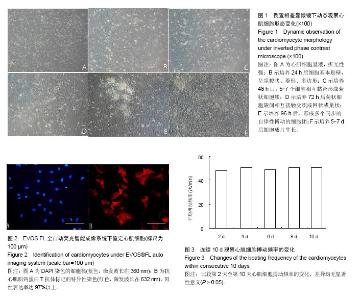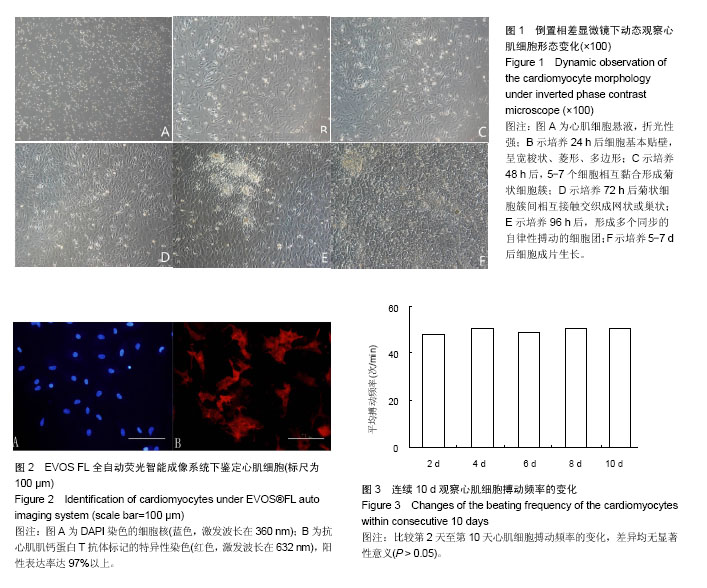| [1] Porrello ER, Mahmoud AI, Simpson E, et al. Transient regenerative potential of the neonatal mouse heart. Science. 2011;331(6020):1078-1080.[2] Porrello ER, Mahmoud AI, Simpson E, et al. Regulation of neonatal and adult mammalian heart regeneration by the miR-15 family. Proc Natl Acad Sci U S A 2013;110(1): 187-192.[3] Mollova M, Bersell K, Walsh S, et al. Cardiomyocyte proliferation contributes to heart growth in young humans. Proc Natl Acad Sci U S A. 2013;110(4):1446-1451.[4] Chlopcikova S, Psotova J, Miketova P. Neonatal rat cardiomyocytes--a model for the study of morphological, biochemical and electrophysiological characteristics of the heart. Biomed Pap Med Fac Univ Palacky Olomouc Czech Repub. 2001;145(2):49-55.[5] 石山慧,吕定超,翟旭雯,等.改良成年小鼠心室肌细胞分离方法[J]. 中国心血管病研究 2016,14(8):748-751,766.[6] 包馨慧,李晓梅,杨毅宁,等. 原代乳鼠心肌细胞分离培养的改进[J]. 新疆医科大学学报,2015,38(5):564-566,570.[7] 蒋学友,张丽,俞晨,等. SD乳鼠心肌细胞原代培养及纯化方法的优化探索[J]. 四川大学学报:医学版,2015,46(2):301-304.[8] den Haan AD, Veldkamp MW, Bakker D, et al. Organ explant culture of neonatal rat ventricles: a new model to study gene and cell therapy. PLoS One. 2013;8(3):e59290.[9] Gerilechaogetu F, Feng H, Golden HB, et al. Production of spontaneously beating neonatal rat heart tissue for calcium and contractile studies. Methods Mol Biol. 2013;1066: 45-56.[10] Graham EL, Balla C, Franchino H, et al. Isolation, culture, and functional characterization of adult mouse cardiomyoctyes. J Vis Exp.2013;(79):e50289.[11] Yu J, Deliu E, Zhang XQ, et al. Differential activation of cultured neonatal cardiomyocytes by plasmalemmal versus intracellular G protein-coupled receptor 55. J Biol Chem. 2013;288(31):22481-22492.[12] Louch WE, Sheehan KA, Wolska BM. Methods in cardiomyocyte isolation, culture, and gene transfer. J Mol Cell Cardiol. 2011;51(3):288-298.[13] Hirt MN, Hansen A, Eschenhagen T. Cardiac tissue engineering: state of the art. Circ Res. 2014;114(2):354-367.[14] Emmert MY, Hitchcock RW, Hoerstrup SP. Cell therapy, 3D culture systems and tissue engineering for cardiac regeneration. Adv Drug Deliv Rev. 2014;69-70:254-269.[15] Domenech M, Polo-Corrales L, Ramirez-Vick JE, et al. Tissue Engineering Strategies for Myocardial Regeneration: Acellular Versus Cellular Scaffolds. Tissue Eng Part B Rev. 2016;22(6): 438-458.[16] Kikuchi K, Poss KD. Cardiac regenerative capacity and mechanisms. Annu Rev Cell Dev Biol. 2012;28:719-741.[17] Weinberger F, Breckwoldt K, Pecha S, et al. Cardiac repair in guinea pigs with human engineered heart tissue from induced pluripotent stem cells. Sci Transl Med. 2016;8(363):363ra148.[18] Pascual-Gil S, Garbayo E, Diaz-Herraez P, et al. Heart regeneration after myocardial infarction using synthetic biomaterials. J Control Release. 2015;203:23-38.[19] Tandon V, Zhang B, Radisic M, et al. Generation of tissue constructs for cardiovascular regenerative medicine: from cell procurement to scaffold design. Biotechnol Adv. 2013;31(5): 722-735.[20] 姬婷婷,徐岩,张建华,等. 新生SD大鼠心肌细胞的原代培养及荧光鉴定[J]. 安徽医科大学学报,2014,49(1):120-122.[21] 王现涛,李浪,苏强,等. 新生大鼠心肌细胞的分离与培养[J]. 中华老年心脑血管病杂志,2015,17(7):745-747.[22] Ehler E, Moore-Morris T, Lange S. Isolation and culture of neonatal mouse cardiomyocytes. J Vis Exp. 2013;(79). doi: 10.3791/50154.[23] Vandergriff AC, Hensley MT, Cheng K. Cryopreservation of neonatal cardiomyocytes. Methods Mol Biol. 2015;1299: 153-160.[24] Vandergriff AC, Hensley MT, Cheng K. Isolation and cryopreservation of neonatal rat cardiomyocytes. J Vis Exp. 2015;(98). doi: 10.3791/52726.[25] Golden HB, Gollapudi D, Gerilechaogetu F, et al. Isolation of cardiac myocytes and fibroblasts from neonatal rat pups. Methods Mol Biol. 2012;843:205-214.[26] Zimmermann WH, Eschenhagen T. Cardiac tissue engineering for replacement therapy. Heart Fail Rev. 2003; 8(3): 259-269.[27] Boateng SY, Hartman TJ, Ahluwalia N, et al. Inhibition of fibroblast proliferation in cardiac myocyte cultures by surface microtopography. Am J Physiol Cell Physiol. 2003;285(1): C171-182.[28] Holden M, Adams LB. Inhibitory effects of cortisone acetate and hydrocortisone on growth of fibroblasts. Proc Soc Exp Biol Med.1957;95(2):364-368.[29] Sun H, Sheveleva E, Xu B, et al. Corticosteroids induce COX-2 expression in cardiomyocytes: role of glucocorticoid receptor and C/EBP-beta. Am J Physiol Cell Physiol. 2008; 295(4):C915-922.[30] Inserte J, Molla B, Aguilar R, et al. Constitutive COX-2 activity in cardiomyocytes confers permanent cardioprotection Constitutive COX-2 expression and cardioprotection. J Mol Cell Cardiol. 2009;46(2):160-168.[31] Simpson P, Savion S. Differentiation of rat myocytes in single cell cultures with and without proliferating nonmyocardial cells. Cross-striations, ultrastructure, and chronotropic response to isoproterenol. Circ Res. 1982;50(1):101-116.[32] Parameswaran S, Santhakumar R, Vidyasekar P, et al. Enrichment of cardiomyocytes in primary cultures of murine neonatal hearts. Methods Mol Biol. 2015;1299:17-25.[33] 孟琳琳,黄莺,马依彤,等.小鼠乳鼠原代心肌细胞的改良培养[J].中国组织工程研究,2015,19(37):5993-5997.[34] Shintani SA, Oyama K, Kobirumaki-Shimozawa F, et al. Sarcomere length nanometry in rat neonatal cardiomyocytes expressed with alpha-actinin-AcGFP in Z discs. J Gen Physiol. 2014;143(4):513-524.[35] Vidyasekar P, Shyamsunder P, Santhakumar R, et al. A simplified protocol for the isolation and culture of cardiomyocytes and progenitor cells from neonatal mouse ventricles. Eur J Cell Biol. 2015;94(10):444-452.[36] Knight E, Przyborski S. Advances in 3D cell culture technologies enabling tissue-like structures to be created in vitro. J Anat. 2015;227(6):746-756.[37] Kawaguchi N, Hatta K, Nakanishi T. 3D-culture system for heart regeneration and cardiac medicine. Biomed Res Int. 2013;2013:895967.[38] Ikonen L, Kerkela E, Metselaar G, et al. 2D and 3D self-assembling nanofiber hydrogels for cardiomyocyte culture. Biomed Res Int. 2013;2013:285678. |

